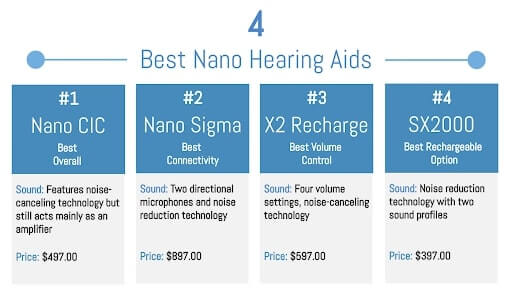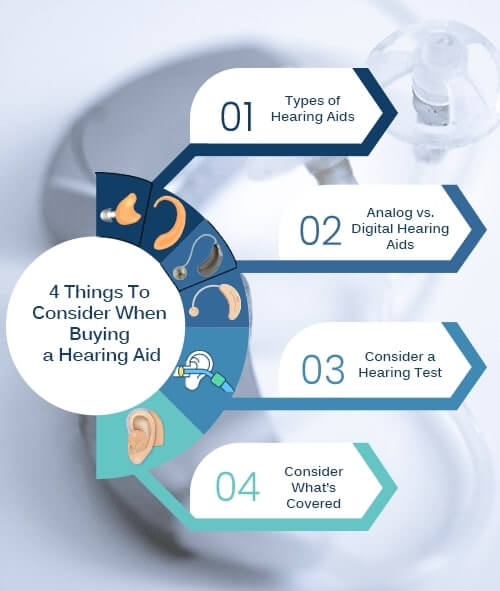The symptoms of hearing loss can be eased by using a hearing aid or amplification device.
Nano Hearing Aids claims to provide high-quality hearing aids to people with a hearing impairment at a fraction of the cost. But, are they legit, or is the company just another hearing aid scam?
This article covers their products, pros and cons, and whether or not they work as advertised.
Quick View
- Best Overall - Nano CIC
- Best Connectivity - Nano Sigma
- Best Volume Control - Nano X2 Recharge
- Best Rechargeable Option - Nano RX2000
Product or Service | Price | Battery Life | Style | Connectivity | Sound Profiles |
Nano CIC | $497.00 | Replaceable, lasts for 14 days | Completely-in-canal | No connectivity | None preset |
Nano Sigma | $897.00 | Replaceable, 6-14 days | Behind-the-ear | Bluetooth connectivity to the smartphone app | None preset |
Nano X2 Recharge | $597.00 | Rechargeable, 16-hour use | Behind-the-ear | No connectivity | Four profiles for sound environments |
Nano SX2000 | $397.00 | Rechargeable, 16-hour use | Behind-the-ear | No connectivity | Two profiles for sound environments |
Quick Verdict
- Best Overall - Nano CIC - A completely-in-canal device that amplifies sound with limited noise reduction capabilities.
- Best Connectivity - Nano Sigma - A behind-the-ear device that can connect to the Nano smartphone app via Bluetooth. Sound quality is lacking, however, and MDHearingAid VOLT+ may be a better overall alternative.
- Best Volume Control - Nano X2 Recharge - A behind-the-ear device that is fully rechargeable and provides four sound profiles for varying noise environments.
- Best Rechargeable Option - Nano RX2000 - A behind-the-ear device that is fully rechargeable and the most affordable option on the list.
What Is Nano Hearing Aid
Nano Hearing Aid is a company claiming to sell over-the-counter (OTC) hearing aids to help people with mild to moderate hearing loss.
By removing the middleman, in their case, an audiologist or hearing specialist, they make affordable hearing aids even cheaper for people to buy.
Who Makes Nano Hearing Aids?
Nano Hearing Aids is one of several hearing aid manufacturers and online hearing aid providers. The company was founded in 2017 and has produced a range of products aimed at helping people improve their hearing without having to visit a doctor or clinic.
Company Reputation
Despite the company only appearing in the hearing aid industry recently, many people have turned to Nano for OTC hearing aids.
Although they sell FDA-registered hearing aids, Nano Hearing Aids only received a B rating from the Better Business Bureau after receiving several complaints regarding their refund policies, device quality, and claims that their hearing aids are more than just personal sound amplification products (PSAPs).
Nano App
As with most modern hearing aid technology, Nano Hearing Aids offers a smartphone app with their Nano Sigma package, from which you can manage the devices’ volume settings and make use of their noise reduction technology.
How Much Do Nano Hearing Aids Cost?
Nano Hearing Aid prices differ according to the model you’re buying. Although they are cheaper than many other OTC hearing aids, their quality and whether or not they work the way they should is doubtful.
Nano Hearing Aid prices typically include a buy one get one free offer and are as follows:
- Nano CIC – $497.00
- Nano Sigma – $897.00
- Nano X2 Recharge – $597.00
- Nano RX2000 – $397.00
In comparison, you can buy a high-quality pair of hearing aids from a well-known brand like MDHearingAid at $799.99 for their AIR model or $1199.99 for their rechargeable VOLT+ model.
Where Can I Buy Nano Hearing Aids?
Nano hearing aids are available for purchase online on the Nano website. They may also be available at several in-person stores or you can buy them from Amazon, where they are listed as Nano hearing assist devices or Nano hearing amplifiers.
Does Walmart Sell Nano Hearing Aids?
No, Walmart does not sell Nano Hearing Aids products. However, they do stock several MD hearing aids from the MDHearingAid brand.
Does Nano Take Insurance?
As Nano hearing devices are registered with the Food and Drug Administration, your purchase of one of their products may be covered by the benefits of your insurance plan. However, you will need to verify this with your insurance provider before buying.
Nano Hearing Aids Pros and Cons
Below are the most significant pros and cons of Nano Hearing Aids products.
Pros
- You can buy the hearing aids online
- Purchase can be made without hearing tests or audiologist visits
- Nano claims their website and the app can perform hearing tests online
- Some products offer app-based feedback control to eliminate unwanted sounds
- The devices are cheaper than many other OTC hearing aids on the market
- The devices provide four different sound environment settings
Cons
- They are not FDA approved
- The company only received a B rating from the Better Business Bureau
- Some claim their hearing aids are just sound amplifiers
- There is no evidence the website or app’s online hearing tests can assess your hearing loss
- Despite their name, Nano Hearing Aids are not true medical hearing aids
Customer Reviews
Before buying a device, it’s vital to check out real customer hearing aid reviews. Nano Hearing Aid reviews are relatively average, with an equal percentage of good and bad experiences recorded on Amazon.
You should note that most positive Nano Hearing Aids reviews refer to devices as amplifiers, not true hearing aids.
Very few positive reviews mention the sound quality, while most only focus on the price.
Customer Complaints
Despite some stellar reviews of Nano Hearing Aids, there is an equal number of unhappy customers who have made their complaints public.
Many reviewers also lament the poor customer service and state the company does not stand by its 45-day money-back guarantee.
While another unhappy customer wrote:
Finally, one other reviewer complained about the devices working as amplifiers, not hearing aids as advertised.
Nano Hearing Aids has also received more than 100 complaints on the Better Business Bureau site, calling their quality and status as hearing aid manufacturers into question.
Warranties and Refunds
Nano Hearing Aids offers a 45-day money-back guarantee. Each device also comes with a one-year standard warranty that covers manufacturing defects.
If you need greater assurance, you can opt for their yearly Elite Protection Plan for $79.00. The additional protection plan covers a yearly discounted upgrade, manufacturing defects, accidental damage, and theft.
If you decide to buy the protection plan, you should note it is non-refundable even if you return your device.
Nano Hearing Aid Models
The four main Nano models are the Nano CIC, X2 Recharge, Sigma, and RX2000. They are summarily reviewed below.

Nano CIC – Best Overall
Feature | Description | Star Rating |
Price | $497.00 | 4.5/5 |
Battery | Replaceable, lasts for 14 days | 4/5 |
Style | Completely-in-canal, nearly invisible | 5/5 |
Sound | Features noise-canceling technology but still acts mainly as an amplifier | 2/5 |
Comfort | Multiple earbud sizes for easy, comfortable use | 4/5 |
Pros
- The completely-in-canal device is nearly invisible.
- Very affordable
- Features noise-canceling technology
- It comes with six months’ worth of batteries with overall longer battery life.
Cons
- Batteries are non-rechargeable
- Noise-canceling technology does not significantly improve the quality of sound.
Nano CIC Digital hearing aids are non-rechargeable, completely-in-canal hearing assistance devices that come with four earbud sizes to ensure a comfortable fit, cleaning supplies, a carrying case, and a six-month supply of batteries.
The CIC hearing aids also come in a Nano CIC Recharge model that offers rechargeable batteries alongside the standard features of the model.
Bottom Line:
Nano CIC works well for people with mild to moderate hearing loss, although its noise reduction technology does not measure up to true medical aids in the same price range.
A good alternative may be the MDHearingAid AIR, which costs only $799.99 and offers high-quality sound and noise cancellation within a sleek model design.
Nano Sigma – Best Connectivity
Feature | Description | Star Rating |
Price | $897.00 | 3/5 |
Battery | Replaceable, 6-14 days | 3.5/5 |
Style | Behind-the-ear, beige | 4/5 |
Sound | Two directional microphones and noise reduction technology | 3/5 |
Connectivity | Bluetooth connectible to the Nano smartphone app | 3.5/5 |
Pros
- Directional mics marginally improve sound quality
- Controlled with the Nano smartphone app
- Sleek behind-the-ear design
Cons
- It can’t be used without a compatible app
- More noticeable design
Nano Sigma wireless hearing aids are Bluetooth enabled and offer supplemental noise reduction technology alongside a directional microphone that slightly improves the sound quality over other models.
Connecting to the smartphone app allows you to adjust volume levels and noise reduction discreetly. The device package includes cleaning supplies and a six-month supply of batteries.
Bottom Line:
The Nano Sigma is a good option for tech-savvy individuals who want to control their devices’ volume and noise reduction remotely. Unfortunately, despite the directional microphones, the sound quality does not compare with other devices in the same category.
If you’re looking for an alternative with better sound quality, the MDHearingAid CORE may be a good option as it also connects to a Bluetooth smartphone app, is a behind-the-ear model, and costs $1199.99 for a pair.
Nano X2 Recharge – Best Volume Control
Feature | Description | Star Rating |
Price | $597.00 | 4/5 |
Battery | Rechargeable, 16-hour use | 4.5/5 |
Style | Behind-the-ear model in Silver or beige | 4/5 |
Sound | Four volume settings, noise-canceling technology | 3.5/5 |
Comfort | Multiple earbud sizes for a better fit | 4/5 |
Pros
- Four sound profiles
- Directional microphones for improved sound quality
- Fully rechargeable batteries
Cons
- Shorter battery life than alternatives
- Limited noise cancellation as the device still acts more as an amplifier.
Despite being a behind-the-ear model, the Nano X2 Recharge is sleek and nearly invisible. Its batteries are fully rechargeable and last up to 16 hours between charging sessions. The Nano X2 comes in both digital and rechargeable versions.
The rechargeable hearing aids come with a free portable charging case, cleaning supplies, and earbud fittings to ensure your comfort. Unfortunately, the Nano X2 Recharge does not improve much on the other Nano models’ sound quality.
Bottom Line:
The rechargeable Nano X2 offers all the features of the digital Nano X2 hearing aids with the added benefit of fully rechargeable batteries.
Despite this, the devices are still lacking in sound quality, and the MDHearingAid VOLT+ may offer a better quality, rechargeable alternative for only $1199.99 a pair.
Nano SX2000 – Best Rechargeable Option
Feature | Description | Star Rating |
Price | $397.00 | 5/5 |
Battery | Rechargeable, 16 hours use | 4.5/5 |
Style | Behind-the-ear, beige | 4/5 |
Sound | Noise reduction technology with two sound profiles | 3/5 |
Comfort | Discreet, BTE fit with multiple earbud sizes | 4.5/5 |
Pros
- Fully rechargeable batteries
- Most affordable model in the product range
- Two sound profiles to switch between
Cons
- The sound quality isn’t great
The Nano RX2000 hearing aids are rechargeable and can switch between two sound profiles, making moving from a noisy environment to one-on-one conversations much simpler.
Unfortunately, sound quality is still relatively lacking, and the device only provides amplification in most cases.
Bottom Line:
Although the Nano RX2000 is the most affordable rechargeable hearing device in the product range, the sound quality doesn’t measure up to other devices. The noise-canceling technology does not always make a difference in noisy environments.
A better alternative may be the MDHearingAid AIR, which is affordable and offers improved sound quality.
Things To Consider When Buying a Hearing Aid
Buying and wearing hearing aids can significantly improve your quality of life. However, there are several factors to consider before purchasing a pair, whether you suffer from mild or severe hearing loss.
Types of Hearing Aids
The type of hearing aid is essential when considering the model you want to buy. Such placement can have a significant impact on your comfort and overall satisfaction with the device.
The types of hearing aids available include:
- Behind-the-ear (BTE): This fits behind your ear and contains the receiver in the device’s body.
- Receiver-in-canal (RIC): The RIC is smaller than a BTE device, with a thin plastic tube linked to an earbud placed inside your ear canal.
- Completely-in-canal (CIC): This involves the entire device being fitted into your ear canal—making the device invisible and can help boost your confidence if you feel self-conscious over people noticing your hearing aids.
- In-the-ear (ITE): ITEs are typically molded to fit your ears and fill up much of your ear’s opening. They are more noticeable than CICs.
Analog vs. Digital Hearing Aids
Analog and digital hearing aids differ in the way they process sound waves. Analog hearing aids work by making continuous sound waves louder. Digital hearing aids receive the sound waves, convert them to a digital signal, and produce a louder duplicate of the sounds received [1].
Digital hearing aids can offer a clearer sound and improved background noise reduction. However, digital hearing aids may be more expensive than their analog counterparts.
Consider a Hearing Test
Before purchasing a hearing aid, consider taking an online or healthcare professional administered hearing test. An online hearing test can’t replace an audiologist examination; however, it can help you determine whether or not you may be experiencing hearing loss.
To find the best hearing test for you, check out the best online hearing tests.
Consider What’s Covered
Once you’ve found a hearing aid brand you’re interested in buying, make a note of possible trial periods, money-back guarantees, refund policies, and warranties so that you can be sure you’re making the right decision.
Refund policies or money-back guarantees are essential so that you can return your devices for a refund should you not be happy with the fit or sound quality.
FAQ
Here are some of the most frequently asked questions about Nano Hearing Aids.
Is Nano Hearing Aid Any Good?
Nano Hearing Aids functions well as a personal sound amplification product. Most Nano products amplify sound while offering minimal noise reduction.
They are not hearing aids that can be used for severe hearing loss or take the place of true medical devices.
What Is the Rating on Nano Hearing Aids?
Nano Hearing Aids have a 3.92/5 rating on the Better Business Bureau. However, there are more than a thousand complaints lodged against the company since its registration.
How Long Do Nano Hearing Aid Batteries Last?
Different models use different batteries. Some, like those in the Sigma, last between 6-14 days. The CIC batteries last for around 14 days, and the rechargeable models can work for 16 hours between charges.
Which Brand of Hearing Aid Is Best?
The best hearing aids should be affordable and provide high-quality sound. Nano Hearing Aids are cheap but fall short when it comes to the quality of sound and noise reduction.
If you are suffering from hearing loss, you may want to consider MDHearingAid hearing devices, which are affordable and provide excellent noise cancellation, whistling, and interference reduction.
For more information on these devices, check out our MDHearingAid review.
Conclusion
The best hearing aids should offer overall good quality sound, battery life, and comfort.
Whether you suffer from mild, moderate, or severe hearing loss, once you’ve taken a hearing test and confirmed you need assistance, you can choose from a variety of affordable, quality products like those offered by MDHearingAid to ensure your condition does not negatively affect your quality of life or happiness.
References:
- Levitt, Harry. “A Historical Perspective on Digital Hearing AIDS: How Digital Technology Has Changed Modern Hearing AIDS.” Trends in Amplification, SAGE Publications, Mar. 2007, www.ncbi.nlm.nih.gov/pmc/articles/PMC4111501/.













Leave a Reply